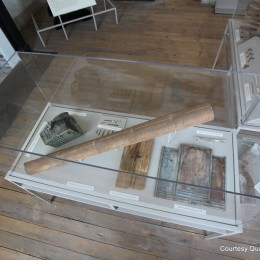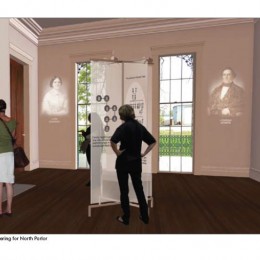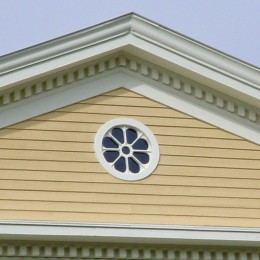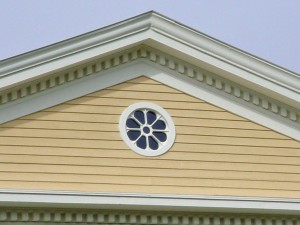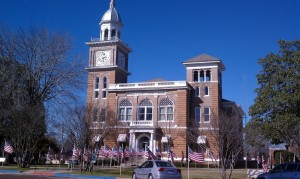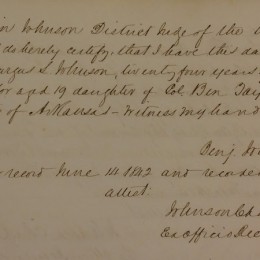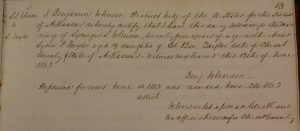Category: News
Holiday Hours 2012-2013
Lakeport will be
Closed:
- November 22-23, 2012 for Thanksgiving
- December 19, 2012-January 1, 2013 for Christmas & New Year’s Day
We’ll resume regular hours on January 2, 2013.
Press Release: Lakeport Plantation to Celebrate Fifth Anniversary
Lakeport closed 9/6-9/28, 2012 for Exhibit Installation
Special Announcement:
We will also be closed on Labor Day, Monday, September 3.
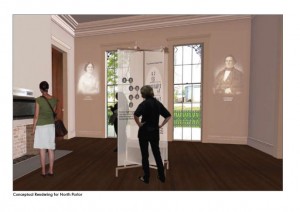 |
| Design Development: North Parlor |
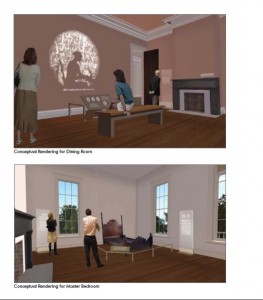 |
| Design Development: Dining Room & Master Bedroom |
Saturday Hours — Summer 2012 — Closed July 4th
June 2, 2012 – July 28, 2012.
Lakeport will be open this summer on Saturdays from 11:00 am until 3:00 pm.
Closed, Wednesday, July 4.
Open, July 5, 6, & 7.
Balusters Return to Lakeport!
Earlier this week, I received a phone call from Realtor, Dottie Collins in Greenville, Mississippi. “Blake,” she said, “your Lakeport balusters are ready to be picked up.” She was referring to the 19 Lakeport balusters, which made up the front porch balustrade, that had been in a Greenville, Mississippi home since 1953. The house had just sold and the new owner was gutting the house. Dottie informed the new owner that the balusters had come from Lakeport and he saved them. I called the new owner and rushed over to the house and found them waiting for me in a large garbage bag.
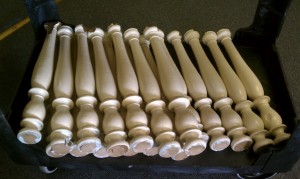 |
| Original Lakeport balusters salvaged in 2012 from a home in Greenville, Mississippi |
Here’s the back story:
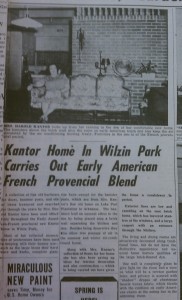 |
| May 26, 1953, The Delta Democrat Times |
Back in 2008, while searching for information about Lakeport in Greenville’s The Delta Democrat Times, I came across an article from May 26,1953 about the new home of Mrs. Harold Kantor in the Wilzin Park neighborhood. The article recounts Mrs. Kantor’s collection of old Americana to decorate her “Early American-French provincial” home. Mrs. Kantor’s collection included “the banister posts, which are from Mrs. Kantor’s fine old home on Lake Port Plantation in Arkansas.” In two photos that accompany the article, you can clearly see the balusters referred to in the article. From the photos, they looked a lot like Lakeport’s originals.
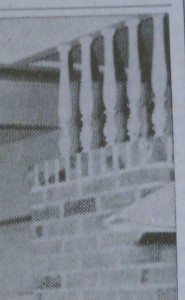 |
| Close-up of balusters in Kantor home, 1953 |
It turns out that Mrs. Harold Kantor was Helen Epstein Kantor, one of Sam Epstein’s three daughters. Sam Epstein purchased Lakeport from the original Johnson family in 1927 and, it seems, Mrs. Kantor took a number of the balusters from Lakeport for her new home in 1953.
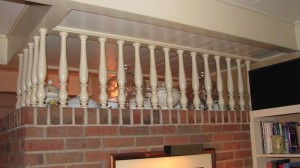 |
| Inside the Kantor home, Wilzin Park, November 2008 |
After a little research, I figured out the address of the home and saw that it was for sale through Collins Real Estate. After learning the balusters were still in the house, I was able to meet with the owner and take several pictures documenting the 19 balusters.
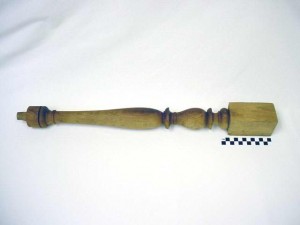 |
| Original baluster found in Lakeport’s commissary |
Before the restoration of Lakeport, it was thought that all the balusters were missing. However, two turned up on a top shelf of the commissary. These two were used to recreate the balustrade during restoration. Now with the donation of the Kantor balusters, we now have almost 30% of the originals. These won’t ever be put back on the house, but will be kept as artifacts for display and references in case we need to make any replacements.
2012 Teacher Workshop
The Arkansas Heritage Sites at Arkansas State University will host a free professional development workshop this summer at Lakeport Plantation. The restored Lakeport Plantation home, built ca. 1859, is the only remaining antebellum Arkansas plantation home along the Mississippi River. The workshop will provide six hours of in-service credit. All workshop themes and activities fit into the Arkansas Social Studies Curriculum Frameworks. The workshop is designed to feature the multi-topic and interdisciplinary educational opportunities available through a great and unique Arkansas Delta site.
This workshop will focus on the role of African Americans during the Civil War and Reconstruction in Arkansas. Guest lectures will be as follows:
- Mark Christ, Community Outreach Director at the Arkansas Historic Preservation Program and author of Civil War Arkansas, 1863: The Battle for a State, will discuss African American regiments in Arkansas during the Civil War.
- Rhonda Stewart, Genealogy and Local History Specialist for the Central Arkansas Library System’s Butler Center for Arkansas Studies, will present “The Legacy of Richard Toombs, United States Colored Troops: From the Civil War to Central High to the White House.”
- Blake Wintory, Ph.D., Assistant Director at the Lakeport Plantation, will discuss the history of Reconstruction and Redemption in Arkansas and Chicot County and the role African American legislators played during that tumultuous and interesting time.
For a full agenda, click here.
For those who are interested in registering for the workshop, registration is available through the Arkansas Heritage Sites website on either the home page or the education page (the registration tool is located in the left hand side link menu): http://
Lakeport Plantation Presents Author: Dr. Robert Patrick Bender, March 17, 2012
 Dr. Robert Patrick Bender will be at the Lakeport Plantation to discuss the life and career Lake Village’s Confederate Brigadier General Daniel Harris Reynolds. Dr. Bender is the editor of Worthy of The Cause for Which They Fight: The Civil War Diary of Brigadier General Daniel Harris Reynolds, 1861-1865 (University of Arkansas Press, 2011). A book signing will follow Dr. Bender’s talk.
Dr. Robert Patrick Bender will be at the Lakeport Plantation to discuss the life and career Lake Village’s Confederate Brigadier General Daniel Harris Reynolds. Dr. Bender is the editor of Worthy of The Cause for Which They Fight: The Civil War Diary of Brigadier General Daniel Harris Reynolds, 1861-1865 (University of Arkansas Press, 2011). A book signing will follow Dr. Bender’s talk.
Books will available for purchase at $35.00 (cash or check only please). Call or email to reserve a book — 870 265 6031 or lakeport.ar at gmail.com

This event is an official event of the Arkansas Sesquicentennial Commission
A Stroll through downtown Warren, Arkansas
After a meeting in Warren (Bradley County), I had the chance to stroll around downtown Warren. I was impressed with how much of its historic fabric is still intact.
The courthouse is an impressive two-story structure designed in 1903 by Little Rock architect Frank W. Gibb. The National Register form on AHPP’s website describes the building as :
an impressive two-story brick structure with towers. Distinctive features of the building include brick quoins arched windows with keystones, gauged brick voussoirs, denticulated cornices, and the usage of two colors of brick. A cut-stone water table extends around the entire building. The most distinctive feature of the building is the clock tower located on the southwest corner. The main body of the tower is two-and-one-half stories with a four-faced clock located atop. Centered above the clock is a cupola featuring archways, denticulated cornice and a hexagonal roof.
Near the courthouse are two Art Deco style buildings, the 1931 Warren Municipal Building and the 1948 Warren YMCA (now the Donald W. Reynolds YMCA after a 2005 remodeling and expansion).
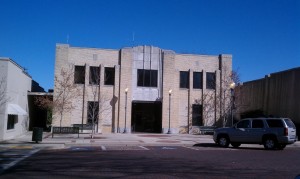 |
| Warren Municipal Building |
 |
| Warren YMCA / Donald W. Reynolds YMCA |
Two other bulding that caught my eye were the First State Bank of Warren (1927) and the Bailey House (ca. 1900). The Bailey house, built for a local druggist, has a unique cupola and other Victorian features. AHPP’s description of the Bailey house claims it “is one of the most architecturally interesting residential structures in south Arkansas.” The First State Bank of Warren struck me with its proportioned neo-classical architecture and the watchful eagle perched atop the building. First State Bank does not appear to be on the National Register.
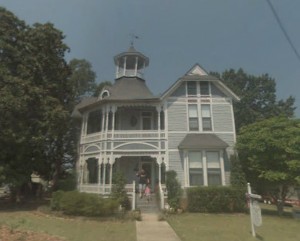 |
| Bailey House |
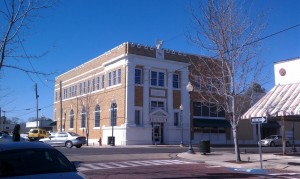 |
| First State Bank of Warren |
There are many other historic buildings in downtown Warren. AHPP’s website lists 13 buildings that are on the National Register, so you can explore more there. Luckily, in July 2012, AHPP will hold a Walks in History Tour and we’ll be able to learn more.
Walks in History Tour sponsored by Arkansas Historic Preservation Program
July 14, 2012 – Historic Downtown Warren
Courthouse Records: Lycurgus Johnson to Lydia Taylor
The marriage of Lycurgus Johnson, age 24, and Lydia Taylor, age 19, on June 13, 1842 is recorded in county records at the Chicot County Courthouse. The marriage was officiated by Lycurgus’ uncle, Benjamin Johnson, who was the Federal Judge for the District of Arkansas.
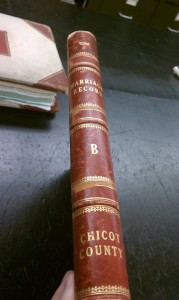 Lydia Taylor was the daughter of Col. Benjamin Taylor. Col. Taylor was among the Kentucky kinsmen who began buying Arkansas land in the 1830s. He had four daughters, Ann Taylor Johnson Worthington (widow of Lycurgus’ uncle James Johnson before marrying Isaac Worthington), Mary Jane Taylor Cable, Lydia Taylor Johnson, and Theodosia Taylor Sessions. Col. Taylor died in 1850 when he and his horse were swept away and drowned during a rainstorm. He is buried in Lexington Cemetery.
Lydia Taylor was the daughter of Col. Benjamin Taylor. Col. Taylor was among the Kentucky kinsmen who began buying Arkansas land in the 1830s. He had four daughters, Ann Taylor Johnson Worthington (widow of Lycurgus’ uncle James Johnson before marrying Isaac Worthington), Mary Jane Taylor Cable, Lydia Taylor Johnson, and Theodosia Taylor Sessions. Col. Taylor died in 1850 when he and his horse were swept away and drowned during a rainstorm. He is buried in Lexington Cemetery.
Lycurgus and Lydia had twelve children during their marriage:
1. Joel Johnson, born May 16, 1843, died Dec. 30, 1847
2. Benjamin Taylor Johnson, born March 25, 1845, died Jan. 8, 1848
3. John Henry Johnson, born Oct. 23, 1846, died Dec. 20, 1847
5. Linnie Johnson, born September 12, 1850
Except for one, all the children, were born in Chicot County, Arkansas at the Florence Plantation or Lakeport Plantation. Linnie Johnson was born in Lexington, Kentucky in September, where the family spent their summers. The couple’s first three children died within three weeks of each other at the Florence Plantation in Arkansas. Mostly likely the cause of their early deaths was a cholera, yellow fever or influenza epidemic. Those three children are buried at the Frankfort Cemetery in Frankfort, Kentucky. The two children who died at Lakeport Plantation after the Civil War, Cable (d. 1867) and Julia (d. 1869) are buried at Lakeport. Lydia and Lycurgus are both buried in the Frankfort Cemetery near Lycurgus’ father, Joel. It is unclear where Lycurgus’ mother, Verlinda Claggett Offutt (1795-1868), is buried. There is no marker for her at Frankfort Cemetery and she’s not listed on Joel’s obelisk marker.
-
Recent Posts
- History of the Mississippi Reading Retreat – April 5, 2025
- Life on the Mississippi Reading Retreat – April 13, 2024
- “A Weary Land” Book Signing with Dr. Kelly Houston Jones
- Literature at Lakeport – “Barracoon” and “The Last Slave Ship” Book Discussions
- Arkansas Archeology Society Cistern Screening, February 18, 2023
-
Archives
- January 2025
- February 2024
- August 2023
- May 2023
- February 2023
- June 2022
- February 2022
- January 2022
- May 2021
- November 2019
- December 2018
- November 2018
- September 2018
- August 2018
- July 2018
- June 2018
- May 2018
- April 2018
- March 2018
- February 2018
- January 2018
- December 2017
- October 2017
- September 2017
- July 2017
- June 2017
- May 2017
- April 2017
- March 2017
- February 2017
- January 2017
- November 2016
- September 2016
- August 2016
- July 2016
- June 2016
- May 2016
- April 2016
- March 2016
- February 2016
- November 2015
- September 2015
- August 2015
- July 2015
- June 2015
- May 2015
- April 2015
- March 2015
- November 2014
- September 2014
- August 2014
- July 2014
- June 2014
- May 2014
- April 2014
- March 2014
- February 2014
- December 2013
- November 2013
- October 2013
- September 2013
- August 2013
- July 2013
- June 2013
- May 2013
- April 2013
- January 2013
- December 2012
- November 2012
- August 2012
- May 2012
- April 2012
- February 2012
- December 2011
- November 2011
- September 2011
- August 2011
- June 2011
- May 2011
- March 2011
- February 2011
- January 2011
- December 2010
- November 2010
- October 2010
- September 2010
- August 2010
- July 2010
- June 2010
- May 2010
- January 2010
- December 2009
- November 2009
- July 2009
- June 2009
- May 2009
- April 2009
- March 2009
-
Meta

